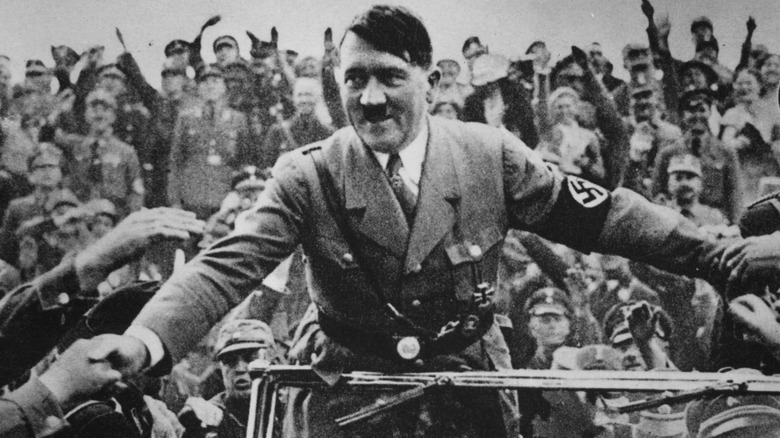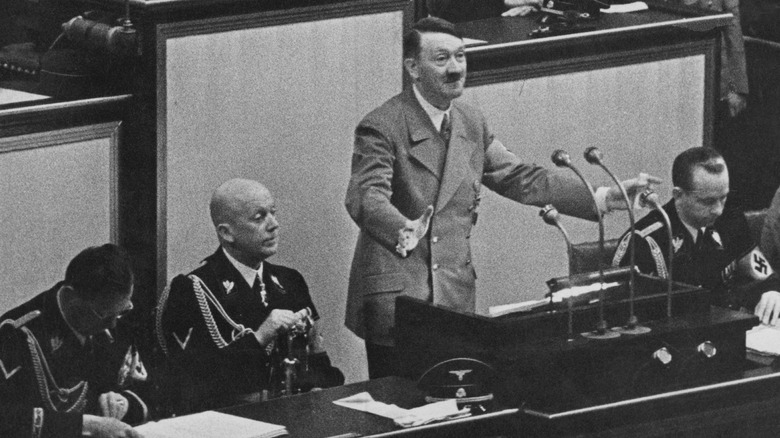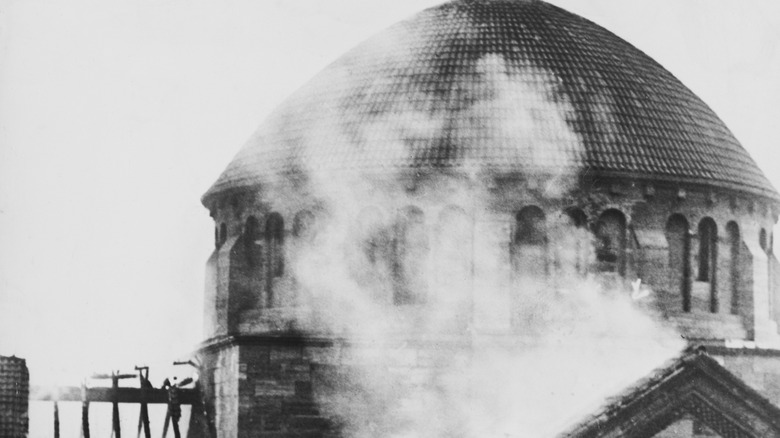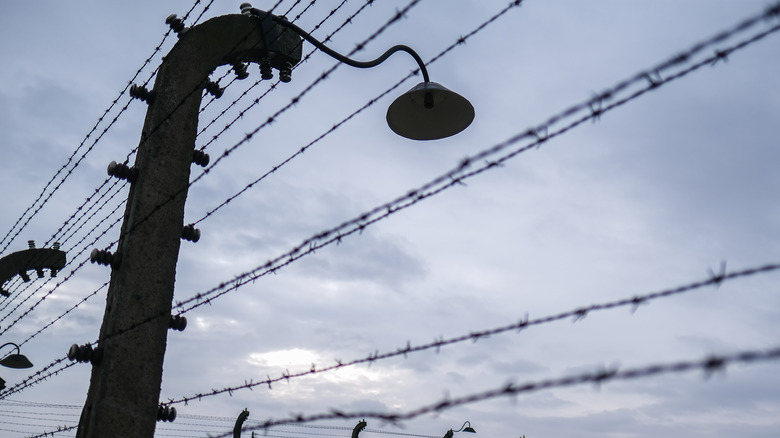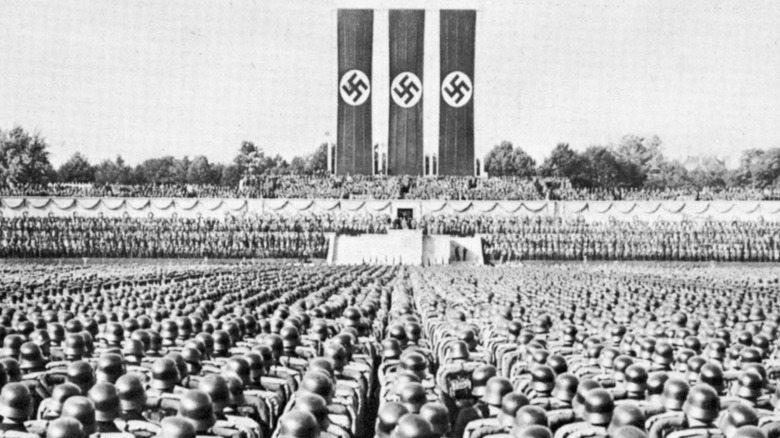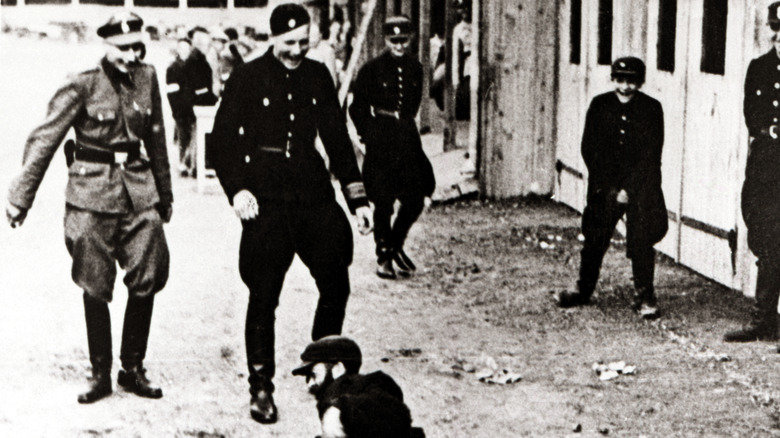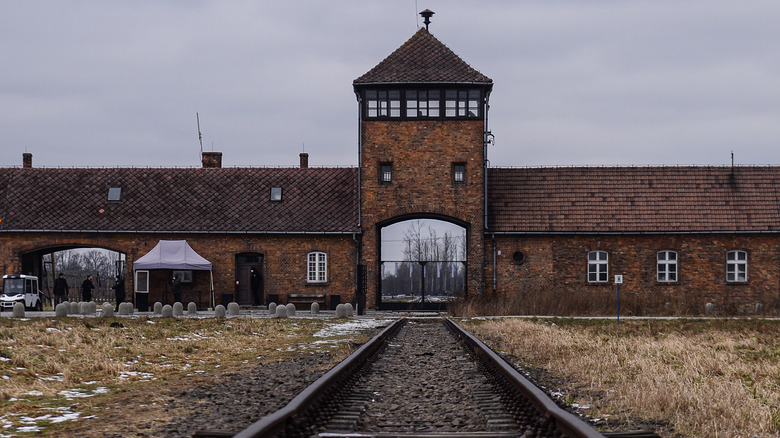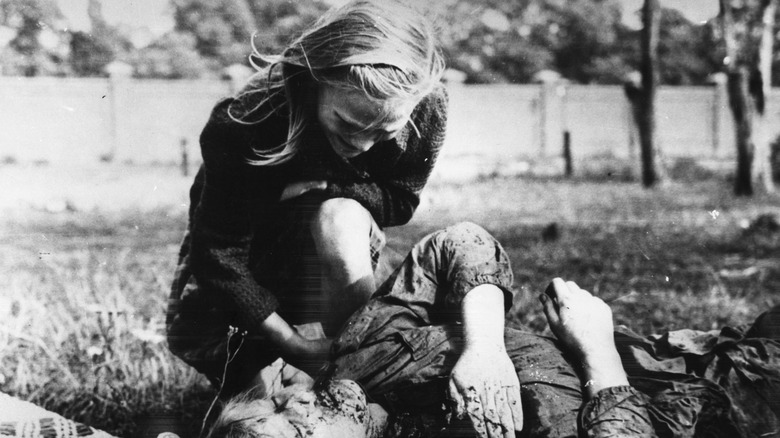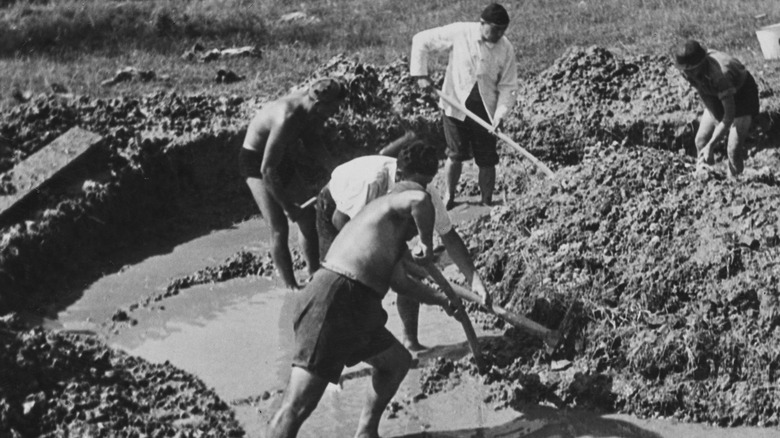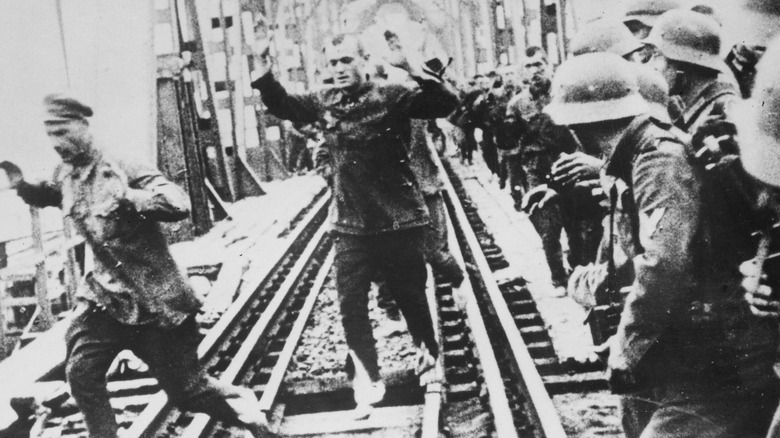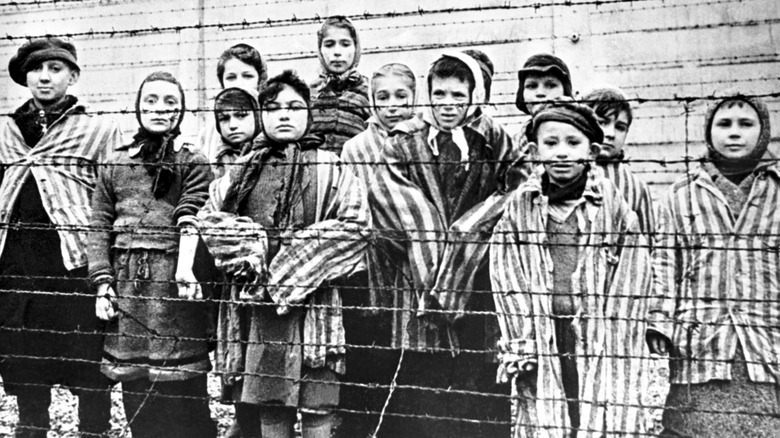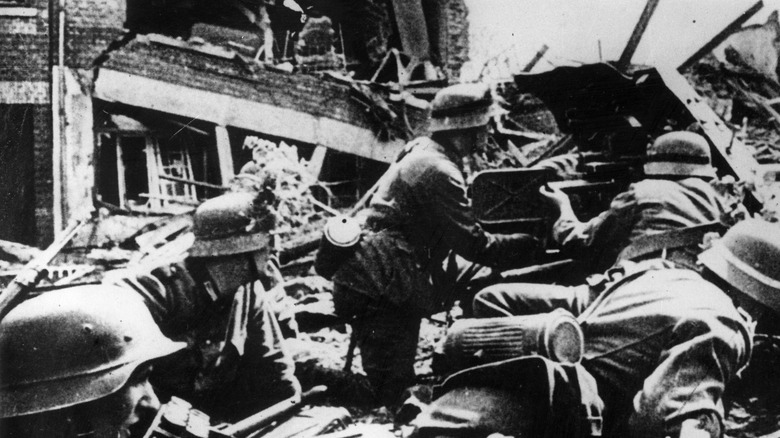The Worst Crimes Ever Committed By Hitler
In recent world history, few individuals are so synonymous with the idea of evil than Adolf Hitler, dictator of Germany from 1933 to 1945 (via Britannica) and architect of the Holocaust. Under his rule scores of people endured brutality and persecution, simply for being part of a racial, ethnic, sexual, or religious group that Hitler and the Nazis deemed undesirable. According to the Illinois Holocaust Museum, some 6 million Jews plus millions of others perished in the network of death camps erected across Europe by the Third Reich — places where beatings, starvation, torture, and death by gassing were routine, creating a system of mass murder on an unprecedented industrial scale.
Hitler's zeal for global expansion meant that countries across Europe were embroiled in World War II, and both civilians and infrastructure were destroyed en masse by aerial bombing campaigns. Many people are familiar with the basic facts about life in Nazi-dominated Europe — yet some of the finer details might not be so widely known. Here are the worst of Hitler's crimes, and how they happened.
Speeches
Adolf Hitler gave numerous speeches in which he blamed Jews for Germany's economic decline. As outlined by the National WW2 Museum, the country had been financially crippled by the Treaty of Versailles, a mandate from the League of Nations that Germans accept blame for starting World War I. The treaty demanded that Germany pay damages in the form of $33 million and give up its military territories overseas. The strain this placed on the economy brought about intense pressures on food supplies and created escalating levels of inflation.
Hitler claimed that Jewish people had conspired to weaken the country, helping to stoke the already high levels of anger felt by patriotic Germans about the country's economic and military emasculation. A central plank of Nazi racial ideology was that Germans were a master race that would purify the world through expansion and conquest, while Jews were an inferior race, hell-bent on global takeover, who had to be exterminated before they seized power.
The scapegoating inspired other Nazi supporters and appealed to many disenfranchised Germans, leading to the rise of antisemitic feeling and outbreaks of violence towards Jews, including Kristallnacht (via the United States Holocaust Memorial Museum).
Kristallnacht
The German ambassador to France, Ernst vom Rath, was killed in November 1938 by a 17-year-old Jewish boy named Herschel Grynszpan, whose family had been deported from Germany to Poland, as reported by the United States Holocaust Memorial Museum. Adolf Hitler's chief of propaganda, Josef Goebbels, described the murder of Rath as a sign of the hostility felt by "international Jewry" towards the Third Reich and Hitler, as per the Jewish Virtual Library.
The outrage this inspired, combined with the antisemitic propaganda spread in previous years by Hitler and Goebbels, helped lead to Kristallnacht, or the Night of Broken Glass — a night in November 1938 where mobs across Germany, Czechoslovakia, and Austria smashed the windows of Jewish-owned homes and businesses.
According to the Jewish Virtual Library, over 90 Jews were killed and between 1,000 and 2,000 places of worship were destroyed. Hundreds more Jews were injured in street violence, while at least 30,000 were deported to concentration camps. Alongside businesses and synagogues, Jewish schools and cemeteries were attacked and saw heavy damages. The government decided not to play a formal role in the attacks but did not discourage them.
Afterwards, senior Nazi officials declared that the Jewish community had provoked what had happened to them. As a result, the insurance companies covering the damage to Jewish buildings were ordered to pay 6 million marks to the German state. A bigger fine of 1 billion marks was imposed on the affected Jewish population as punishment for the murder of Rath.
Targeting of minorities
After Adolf Hitler became chancellor of Germany in 1933, the arson attack on the German parliament, known as the Reichstag Fire, led to a state of emergency being declared across Germany, as per the Monthly Review. Mass groups of communists were arrested along with non-Nazi intellectuals and political activists, many but not all of them being Jewish.
As described by the Jewish Virtual Library, concentration camps sprang up across the country as places to hold those considered enemies of the state. Dachau was among the first, along with Oranienberg, Sachsenburg, Esterwegen, and Berlin Columbia Haus.
As well as holding suspected political dissidents, they contained anyone caught listening to foreign radio stations, people regarded as "asocial," Jehovah's Witnesses, members of Roma and traveler communities, homosexual men, and Jews. Jehovah's Witnesses in particular were singled out for their refusal to take oaths, including swearing allegiance to the Third Reich, on religious grounds. Before becoming centers of mass extermination, many camps were places of slave labor and brutal treatment, including torture.
The Nuremberg Laws
Since 1933 the Nazis had denied Jews the right to work in political or civil service roles, public media, or farming, and they had been barred from the stock exchange since 1934, as outlined in original Nazi documents (via the National Archives). This was a period when the Nazis, still wary of a public backlash, were exercising self-restraint with regard to what they saw as "the Jewish question."
However by 1935, under pressure from more radical members of the Nazi party, the gloves were soon off; Third Reich plans for the Jewish population were cemented with Adolf Hitler's introduction of the Nuremberg Laws, where Jews in Germany were disenfranchised and formally stripped of citizenship.
The two main decrees that came into place were called the Law of the Reich Citizen and the Law for the Protection of German Blood and German Honour. As outlined by Britannica, the former stated that Jews were no longer citizens but "subjects," while the latter forbade Jews from marrying non-Jews, particularly those the Nazis deemed as racially superior.
Until 1945, around 2,000 anti-Semitic rules were introduced across Nazi-occupied territory. According to the British Library, they included forcing Jews to wear a yellow star on their clothes. Many saw their businesses and other assets seized by the state and were banned from going into parks, cafes, shops, and cinemas, as well as owning electrical equipment or traveling abroad. In short, persecution was not just encouraged, but legal.
The ghettos
Jews in countries run by the Nazis, including Poland, Romania, Hungary, and Czechoslovakia, were forced to leave their homes and enter partitioned areas of cities across Europe such as Warsaw, Łódź, Krakow, Lublin, and Lvov. The University of South Florida points out that while not all Jews were sealed in brick by brick, many were kept in by barbed wire and high wooden fences. Those who tried to leave would be shot by the guards permanently stationed at the entrances. Most who entered did not leave alive.
At the very minimum ghettos could hold 3,000 people, while the largest, the Warsaw ghetto, housed 400,000. Conditions were squalid and cramped, with multiple families often forced to share one room. The filth, lack of access to clean water or sanitation, and close proximity to strangers meant that many people died from disease. Others froze to death during the winters from poor clothing and lack of access to fuel to heat their meager homes. Many died from starvation, as they were given food rations that provided as little as 800 calories per day, according the Wiener Holocaust Library.
Despite this, many people tried to hold on to a sense of normality and dignity, such as carrying out rituals for Jewish worship and secretly educating their children, notes the University of South Florida. Others bribed guards, climbed over walls, or crawled through sewers to sustain the black market demand for food and medical supplies, as per the Wiener Holocaust Library. Yet eventually the ghettos would be emptied — for horrifying reasons.
The death camps
Overseen by Adolf Hitler, from 1941-1945, Jews were deported to concentration camps like Auschwitz, Treblinka. and Belzec. According to the Wiener Holocaust Library, prior to this Nazi, policy had been to forcibly deport Jews or encourage them to leave. However, doing this for the whole Jewish population was not possible. As a result the Nazis created death camps designed to permanently get rid of Europe's Jews, in what became known as the Holocaust.
Many were removed from the ghettos and packed into trains designed to carry freight, provided with no food, water, or sanitation, traveling for days at a time in extreme heat or cold, as per the United States Holocaust Museum. Many didn't survive the journey.
For the millions who left the trains alive, on arrival at the camps they were processed via a deadly selection process. Those who were rejected were exterminated by use of poisoned gases like carbon monoxide and Zyklon B, firstly in gas vans and then later in stationary chambers, if they were considered unfit to work. They included the elderly, the sick, and young children. Once rejected, they would be told to leave their belongings and undress before being herded into tightly sealed chambers in which they were killed instantly. Their bodies were sent to be cremated so that the process would begin again.
As the Wiener Holocaust Library notes, others died from starvation, beatings, torture, and shootings at the hands of camp guards. In total, the Holocaust is estimated to have led to the deaths of 6 million Jews, and millions of others (via the Illinois Holocaust Museum).
Invasion of Poland
Adolf Hitler's decision to send German tanks across the Polish border in September 1939 indicated his refusal to be appeased by other powers such as the United States and Britain. As described by Life magazine, the German advance was formidable; the invasion of Poland was brought about by more 1.5 million soldiers, 2,500 tanks, and 2,000 war planes (via Time) — an unprovoked full-on assault brought about by Hitler's belief in "lebensraum," or the need for Germans to access more land through violent conquest in order to expand and prosper.
The advance of Germany led to heavy bombings and casualties across Poland, with soldiers murdering both civilians and military personnel with no discrimination between the two, resulting in Poland's eventual desecration and total takeover. The assault lasted barely five weeks, as the Polish military, which fought hard, was ill-equipped against the immense and robust German war machine and the advance from the Soviet Union in the East, which came two weeks after the invasion by Hitler. Those who survived were left to bury the dead in streets and parks.
The act not only saw Hitler begin his planned conquest of the rest of Europe but prompted the declaration of war on Germany by the allied powers, leading to the beginning of World War II and the mass suffering on a global scale that followed.
Slave labor
The Nazis used slave labor on an enormous scale. Initially forced labor was introduced in 1933 as a way for the Nazis to control those they deemed racially inferior or regarded as political opponents of Adolf Hitler's regime, as described by the United States Holocaust Memorial Museum.
When war broke out in 1939, forced labor became an essential part of the German military juggernaut, with people from across Europe forced to work in munitions, farming, and construction. Inmates at the various concentration camps, particularly Jews and Soviet prisoners of war, were increasingly required to build and maintain their own prisons.
The Nazis would subject Jews to especially punishing forms of physical labor as a way to bring about "annihilation through work." Laborers were subject to horrible treatment, starvation, and exhaustion. A lot of this work did not contribute to the war effort and was simply designed to cause the inmates considerable pain and suffering, according to Birkbeck University.
Some of the camps, notably Auschwitz and Ravensbrueck, kept women in bordellos as a way to boost levels of prisoner productivity. Author Robert Sommer states in his book "Das KZ-Bordell" (via Reuters) that this was rooted in Heinrich Himmler's belief that sexual favors would encourage soldiers to work harder — even though this was rarely the case.
Treatment of Soviet prisoners of war
Soldiers from the Russian army who had been captured by the Nazis were imprisoned in the camps and often used as part of Nazi experiments in mass ethnic cleansing. As outlined by the United States Holocaust Memorial Museum, Soviet POWs were seen as racially inferior as well as barriers to Adolf Hitler's desire for the Third Reich to expand and grow. Soviet prisoners were given rations of only 700 calories per day, with many dying from starvation.
Furthermore, the overcrowding, lack of adequate provisions, and constant exposure to the cold meant that in the autumn of 1941, 5,000 inmates were dying every day from diseases such as dysentery and typhoid. Other Russian soldiers were executed via mass shootings, which took place in separate, sealed off areas away from the camps. The inmates at camps such as Flossenburg were burned alive by members of the SS.
Perhaps the most sinister use the Nazis found for Soviet soldiers were as Guinea pigs in their experiments with poisonous gas. Six hundred Russian POWs were selected to be executed with Zyklon B in September 1941, and their successful extermination at Auschwitz meant that gassing was used widely as a way to kill people en masse with little effort.
The death marches
As the United States Holocaust Museum details, when news of the Red Army's advance reached the Nazis in 1945, many of them forced prisoners from camps such as Dachau and Auschwitz to march in brutal conditions across Nazi-held territory, in an effort to prevent the allies from liberating the camps. Many of the prisoners were starved, emaciated, and suffering from disease as a result of their incarceration. Thousands were unable to move as fast as they were commanded to by the guards, and those who collapsed were shot on site.
These "mobile concentration camps," as described by the Wiener Holocaust Library (via the Guardian), saw prisoners murdered even as they walked through Austrian and German villages and towns. Female prisoners were sexually assaulted by guards, and the few who survived or escaped still had to fight so survive.
The Library of Congress states that around 250,000 people died on the marches. It was a sign that liberation did not happen in a single moment; it was a long and bloody process that was resisted vehemently by the Nazis.
Child soldiers
As the Nazis realized they were losing the war, Adolf Hitler tried to bolster the numbers of the German army by recruiting boys from the Hitler Youth.
They were bribed into joining by being given sweets and chocolate, even though many were ill-equipped to fight. According to Harald Stutte's book, "Hitler's Forgotten Kids" (as referenced in the Express), boys often had barely a half day of training in using anti-tank missile launchers before being given an SS uniform and sent to fight the Soviet army. Some were as young as 15, and many were excited to be fighting for the Third Reich after years of being raised on a diet of little more than Hitler's poisonous ideology. Yet given that Germany would lose the war, for most it was guaranteed suicide.
Thousands perished in combat at the hands of Russian soldiers who had little time for pity after experiencing the brutality of the German war machine. Other boys were executed for desertion when they tried to return home to their families. Unmarked graves containing teenagers who had been shot in the head were excavated years later.
